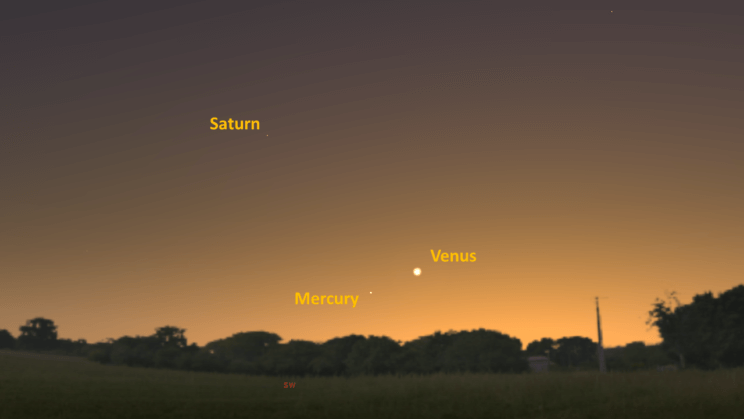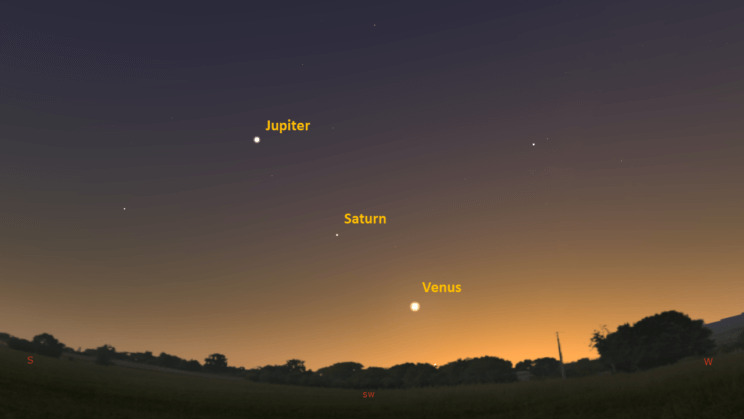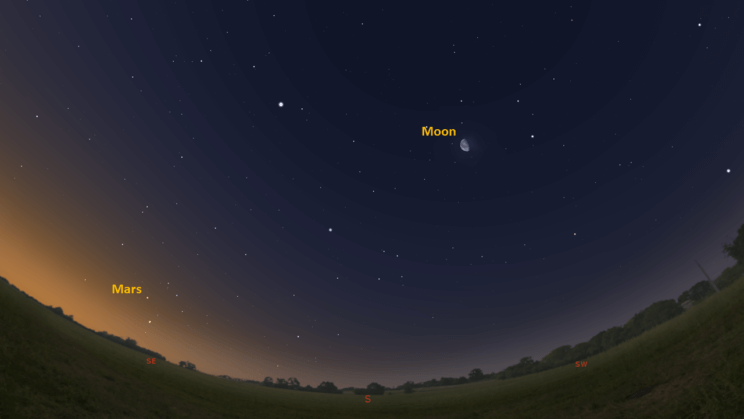This is the Saint Louis Science Center’s NIGHT SKY UPDATE for the week of Friday, December 24, 2021.
Information updated weekly or as needed.
Times given as local St. Louis time which is Central Standard Time (CST). For definitions of terminology used in the night sky update, click the highlighted text. If relying on times posted in Universal Time (UT), St. louis is -6 hours when CST.
Public Telescope Viewings
With the changing recommendations from the CDC regarding COVID-19, conversations regarding the return of star parties at the Saint Louis Science Center have begun. We are close to bringing back our public telescope viewings, but a few details still need to be worked out. We will post future updates as we learn more about when we can bring back telescope viewings.
Observing Highlight of the Week

Mercury and Venus reach conjunction on December 29, 2021. A Look for them in the southwest after sunset. Image created using Stellarium.
This week the planets Mercury and Venus will reach conjunction on December 29, 2021. You can look for the pair in the southwest after sunset. The two inferior planets are moving in opposite directions. From our view on Earth, Venus is headed towards the Sun and Mercury is elongating away from the Sun. As December 2021 comes to an end, Venus will reach inferior conjunction on January 8, 2021. Mercury has just started an apparition and will reach maximum eastern elongation on January 7, 2021. This week the two planets will pass one another in the sky and will later be joined by the Moon in early January.
Mercury was at superior conjunction on November 28, 2021. This occurs when Earth and Mercury are on opposite sides of the Sun. As Mercury climbs out of the Sun glare, it will appear its brightest for this apparition. Mercury appears its brightest near superior conjunction because it is presenting a gibbous phase. As Mercury heads towards maximum elongation the gibbous phases will turn to a quarter. After maximum elongation, Mercury will head back to the Sun as it moves to inferior conjunction on January 23, 2022. Once Mercury heads back to the Sun it will exhibit a crescent phase.
Venus is preparing to pass between us and the Sun. Each day Venus will present a thinner crescent phase. This is when Venus becomes its brightest. It seems odd that when exhibiting a crescent phase, Venus is brighter. This happens because Venus is much closer to use at this point. Mercury does not get brighter near inferior conjunction because it is much smaller and is farther away. After January 8, 2021, Venus will begin to climb out of the Sun’s glare in the morning before sunrise. It will remain visible in the east before sunrise next year until October. The next maximum western elongation occurs for Venus on March 20, 2022.
The motion of the planets was key to the discovery of our solar system. You can follow in our ancestors’ footsteps this week as we see Mercury and Venus dance in the sky. Terms like conjunction, inferior and superior planets and planetary elongations, are useful for understanding the motion of planets and how to find them. In-the-sky.org and heavens-above.com are
The Sun and Moon

The Moon as seen from the International Space Station, on July 31, 2011.
Credit: NASA
Sunrise is at 7:16 a.m. on Friday, December 24 and sunset is at 4:45 p.m. providing us with roughly 9.5 hours of daylight. Even after sunset, the light from the Sun will dimly illuminate our sky for roughly 1 hour and 30 minutes. This period is called twilight, which ends around 6:21 p.m. this week. For those with a sundial, local noon occurs around 12:00 a.m. this week.
| Day | Sunrise | Sunset |
|---|---|---|
| 2021-12-24 | 7:16 a.m. | 4:45 p.m. |
| 2021-12-25 | 7:17 a.m. | 4:45 p.m. |
| 2021-12-26 | 7:17 a.m. | 4:46 p.m. |
| 2021-12-27 | 7:17 a.m. | 4:47 p.m. |
| 2021-12-28 | 7:18 a.m. | 4:47 p.m. |
| 2021-12-29 | 7:18 a.m. | 4:48 p.m. |
| 2021-12-30 | 7:18 a.m. | 4:49 p.m. |
| 2021-12-31 | 7:18 a.m. | 4:50 p.m. |
| 2022-01-01 | 7:19 a.m. | 4:50 p.m. |
Moon
Moonrise for Friday, December 24 occurs at 10:01 p.m. and moonset will occur at 11:36 a.m. on the following morning. On Friday, December 24 the Moon will exhibit a waning gibbous phase with 73% of the lunar disk illuminated. Last quarter moon occurs on December 26, 2021, at 8:24 p.m.
International Space Station (ISS) Observing

Visible passes of ISS from St. Louis for the week of December 24 occur during morning hours. The best pass this week occurs the morning of January 1. Use the table below for information about this and other visible passes this week.
Catch ISS from St. Louis starting Friday, December 24
| Date | Starts | Max. altitude | Ends | |||||||
|---|---|---|---|---|---|---|---|---|---|---|
| Time | Alt. | Az. | Time | Alt. | Az. | Time | Alt. | Az. | ||
| 25 Dec | -1.4 | 05:28:24 | 15 | NNE | 05:28:24 | 15 | NNE | 05:29:17 | 10 | NNE |
| 01 Jan | -1.4 | 06:21:23 | 10 | NNW | 06:23:31 | 16 | NNE | 06:25:38 | 10 | ENE |
Magnitude (Mag): The Measure of brightness for a celestial object. The lower the value is, the brighter the object will be.
Altitude (Alt): The angle of a celestial object measured upwards from the observer’s horizon.
Azimuth (Az): The direction of a celestial object, measured clockwise from an observer’s location with north being 0°, east being 90°, south being 180° and west being 270°.
For information about ISS flyovers and other visible satellites, visit www.heavens-above.com
Detailed information regarding all unmanned exploration of our universe, missions past, present, and planned, can be found at Jet Propulsion Laboratories:
The Visible Planets

Looking southwest, at 5:15 p.m. December 24, 2021. Credit: Stellarium, EG

Looking south, at 6:30 am, December 25, 2021. Credit: Stellarium, EG
This week, five naked eye planets are visible. Mercury returns to the evening sky in the southwest along with Venus, Jupiter and Saturn after sunset. Mars is still tough to see but it is steadily climbing out of the Sun’s glare in the east before sunrise.
Mercury
Mercury is starting another evening apparition. Those with clear horizons in the southwest will see Mercury appear around December 25, 2021, after sunset. On the 29th this month, Mercury and Venus will reach conjunction. This night will be an ideal time to try and spot the elusive planet. Mercury reaches greatest eastern elongation on January 7, 2021.
Venus
Venus is nearing the end of another evening apparition. It will be visible in the southwest as the sun sets. Venus will set at 6:28 p.m. Venus is on its way back towards the Sun’s glare as it approaches inferior conjunction on January 8, 2022. Venus is now bright enough to be seen naked eye during the day. If you have never attempted to spot Venus in the day, near sunset is the time to begin. As always, use precaution when trying to find something in the day as the Sun will be in the sky. Remember to never look directly at the Sun.
Mars
A new apparition for Mars has begun. Mars rises at 5:26 a.m. It will reach 10° above the horizon by 6:30 a.m. being found above the southern horizon. Mars will continue to climb out of the Sun’s glare as we see the end of 2021. Mars reaches opposition next year on December 7, 2022.
Jupiter
Jupiter has passed opposition and as such will be visible after sunset. Look for Jupiter in the southwest as it starts to darken outside. Jupiter sets at 9:10 p.m. and will set about 30 minutes earlier each week. Jupiter reaches superior conjunction on March 5, 2022. This means we can count on seeing Jupiter in the southern skies for the rest of this year and well into 2022.
Saturn
Saturn is past opposition which means it will be visible about 20 minutes after sunset. Right now, it can be found in the southwest after sunset. Saturn sets at 7:39 p.m. Saturn will reach superior conjunction on February 4, 2022.
James S. McDonnell Planetarium
Night Sky Update: December 24 – January 1, 2022







